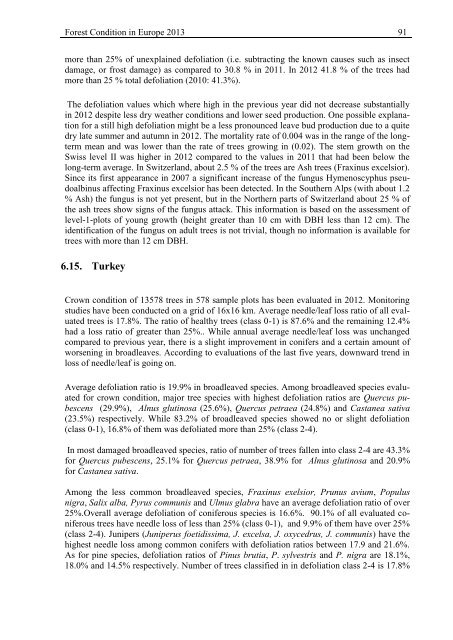Forest Condition in Europe - ICP Forests
Forest Condition in Europe - ICP Forests
Forest Condition in Europe - ICP Forests
You also want an ePaper? Increase the reach of your titles
YUMPU automatically turns print PDFs into web optimized ePapers that Google loves.
<strong>Forest</strong> <strong>Condition</strong> <strong>in</strong> <strong>Europe</strong> 2013 91<br />
more than 25% of unexpla<strong>in</strong>ed defoliation (i.e. subtract<strong>in</strong>g the known causes such as <strong>in</strong>sect<br />
damage, or frost damage) as compared to 30.8 % <strong>in</strong> 2011. In 2012 41.8 % of the trees had<br />
more than 25 % total defoliation (2010: 41.3%).<br />
The defoliation values which where high <strong>in</strong> the previous year did not decrease substantially<br />
<strong>in</strong> 2012 despite less dry weather conditions and lower seed production. One possible explanation<br />
for a still high defoliation might be a less pronounced leave bud production due to a quite<br />
dry late summer and autumn <strong>in</strong> 2012. The mortality rate of 0.004 was <strong>in</strong> the range of the longterm<br />
mean and was lower than the rate of trees grow<strong>in</strong>g <strong>in</strong> (0.02). The stem growth on the<br />
Swiss level II was higher <strong>in</strong> 2012 compared to the values <strong>in</strong> 2011 that had been below the<br />
long-term average. In Switzerland, about 2.5 % of the trees are Ash trees (Frax<strong>in</strong>us excelsior).<br />
S<strong>in</strong>ce its first appearance <strong>in</strong> 2007 a significant <strong>in</strong>crease of the fungus Hymenoscyphus pseudoalb<strong>in</strong>us<br />
affect<strong>in</strong>g Frax<strong>in</strong>us excelsior has been detected. In the Southern Alps (with about 1.2<br />
% Ash) the fungus is not yet present, but <strong>in</strong> the Northern parts of Switzerland about 25 % of<br />
the ash trees show signs of the fungus attack. This <strong>in</strong>formation is based on the assessment of<br />
level-1-plots of young growth (height greater than 10 cm with DBH less than 12 cm). The<br />
identification of the fungus on adult trees is not trivial, though no <strong>in</strong>formation is available for<br />
trees with more than 12 cm DBH.<br />
6.15. Turkey<br />
Crown condition of 13578 trees <strong>in</strong> 578 sample plots has been evaluated <strong>in</strong> 2012. Monitor<strong>in</strong>g<br />
studies have been conducted on a grid of 16x16 km. Average needle/leaf loss ratio of all evaluated<br />
trees is 17.8%. The ratio of healthy trees (class 0-1) is 87.6% and the rema<strong>in</strong><strong>in</strong>g 12.4%<br />
had a loss ratio of greater than 25%.. While annual average needle/leaf loss was unchanged<br />
compared to previous year, there is a slight improvement <strong>in</strong> conifers and a certa<strong>in</strong> amount of<br />
worsen<strong>in</strong>g <strong>in</strong> broadleaves. Accord<strong>in</strong>g to evaluations of the last five years, downward trend <strong>in</strong><br />
loss of needle/leaf is go<strong>in</strong>g on.<br />
Average defoliation ratio is 19.9% <strong>in</strong> broadleaved species. Among broadleaved species evaluated<br />
for crown condition, major tree species with highest defoliation ratios are Quercus pubescens<br />
(29.9%), Alnus glut<strong>in</strong>osa (25.6%), Quercus petraea (24.8%) and Castanea sativa<br />
(23.5%) respectively. While 83.2% of broadleaved species showed no or slight defoliation<br />
(class 0-1), 16.8% of them was defoliated more than 25% (class 2-4).<br />
In most damaged broadleaved species, ratio of number of trees fallen <strong>in</strong>to class 2-4 are 43.3%<br />
for Quercus pubescens, 25.1% for Quercus petraea, 38.9% for Alnus glut<strong>in</strong>osa and 20.9%<br />
for Castanea sativa.<br />
Among the less common broadleaved species, Frax<strong>in</strong>us exelsior, Prunus avium, Populus<br />
nigra, Salix alba, Pyrus communis and Ulmus glabra have an average defoliation ratio of over<br />
25%.Overall average defoliation of coniferous species is 16.6%. 90.1% of all evaluated coniferous<br />
trees have needle loss of less than 25% (class 0-1), and 9.9% of them have over 25%<br />
(class 2-4). Junipers (Juniperus foetidissima, J. excelsa, J. oxycedrus, J. communis) have the<br />
highest needle loss among common conifers with defoliation ratios between 17.9 and 21.6%.<br />
As for p<strong>in</strong>e species, defoliation ratios of P<strong>in</strong>us brutia, P. sylvestris and P. nigra are 18.1%,<br />
18.0% and 14.5% respectively. Number of trees classified <strong>in</strong> <strong>in</strong> defoliation class 2-4 is 17.8%
















